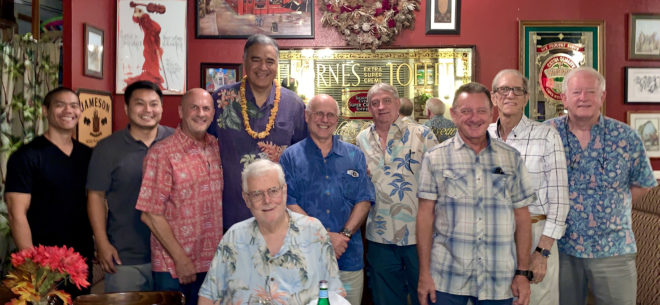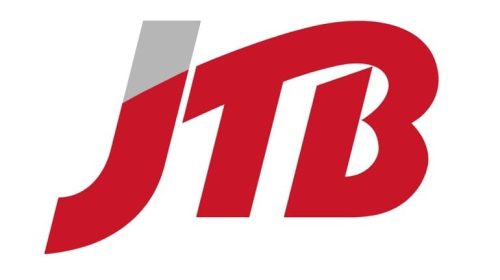Mufi Hannemann: A Candid Talk Story
Former Honolulu Mayor Mufi Hannemann is one of the most recognizable politicians and business leaders in the islands. As a political observer and writer in Hawaii for 35-years, when the opportunity presented itself to sit across a dinner table for two hours with Mufi to talk story, I was ready. Hannemann was the guest speaker at the November 13, 2019, Hawaii Tourism Wholesalers Association (HTWA) dinner meeting. HTWA is a relatively small organization and the collegiality at their monthly dinner meetings encourages a casual open dialog. All came away impressed and with many questions answered about the current condition of Hawaii’s tourism industry, its inherent local politics and its future prospects in the troubled international marketplace.
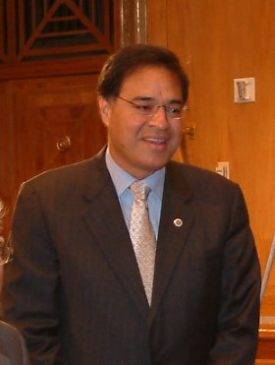
Currently, the President & CEO of the Hawaii Lodging and Tourism Association (HLTA), Hannemann’s organization is the state’s largest private sector visitor association which represents “over 700 lodging properties and businesses through education, advocacy, and philanthropy.” HLTA’s signature philanthropic event is its annual Visitor Industry Charity Walk which this year raised a record $2.7 million to benefit 350 nonprofit groups throughout Hawai‘i.
Hannemann attended ‘Iolani School on a scholarship, where he became an all-star athlete in football and basketball, ultimately becoming the student body president and was honored with the Headmasters Award, the school’s highest recognition at graduation. He graduated cum laude with a bachelor’s degree in government from Harvard University where he lettered in basketball and continued his education as a Fulbright Scholar at Victoria University in Wellington, New Zealand. After a brief teaching and basketball coaching career at Iolani, Hannemann entered government service as a special assistant to Governor George Ariyoshi, and later went to Washington DC where he served in President Jimmy Carter’s Administration at the US Department of the Interior. He was later selected as a White House Fellow during President Ronald Reagan’s Administration which led to him becoming a staff assistant to Vice President George H. W. Bush.
He was later appointed by President Bill Clinton as the United States Representative to the South Pacific Commission, and was a member of President George W. Bush’s Council on the 21st Century Workforce. He later founded the Pacific Century Fellows (PCF) modeled after the White House Fellows, which has mentored and encouraged 17 classes of future generations of local leaders. Alumni have included, such notables as, Peter Ho, Chairman of Bank of Hawai‘i, U.S. Senator Brian Schatz, the late U.S. Representative Mark Takai, journalist and playwright Lee Cataluna, John Leong founder of KUPU, the University of Hawai‘i’s Dean of the College of Social Sciences Denise Konan, and its General Counsel Carrie Okinaga. He also started a chapter of the Fellows Program in Saipan which has produced six classes of these young emerging leaders thus far. Locally, Hannemann has served in Governor John Waihe‘e’s Cabinet as the Director of the Hawaii Office of International Relations, and as the State Director of the Hawaii Department of Business, Economic Development and Tourism. He has weekly radio shows on 107.9 Hawaii’s Kool Gold and KNDI Radio 1270 AM, and writes a weekly column in Honolulu’s MidWeek.
For over 25 years he has personally contributed thousands of dollars of scholarships to high school seniors throughout the state.
Hannemann gained much of his business and management acumen while working in agribusiness as a corporate executive for his business mentor (1984 to 1991), the legendary CEO of C. Brewer and Company, the late John W. A. “Doc” Buyers. C. Brewer was the oldest of Hawaii’s “Big 5” corporations.
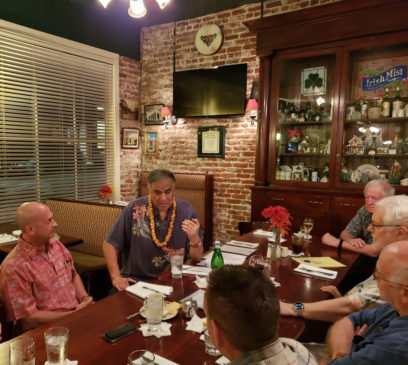
During his HTWA presentation, Hannemann stressed the fact that Hawaii’s $18 Billion tourism industry continues to be one of the mainstays of Hawaii’s economy and he has a different take on how our economy might become more diversified saying, “In the end, it all comes back to tourism.”
Acknowledging the problems with overtourism hot spots, he believes that “the state and the industry should work together to manage tourism better, and place more emphasis on creating synergism within its core competence tourism so as to foster cultural, agricultural, health, environmental, educational, arts, and sports tourism in order to create a reputation that Hawai‘i is not only a great place to vacation but is also a great place to invest, learn, and have a quality experience.” Hannemann is very supportive of the new management and the direction being taken at the Hawaii Tourism Authority (HTA) and he has a long and cordial relationship with the new HTA CEO Chris Tatum who comes out of the hotel industry (Marriott International). Hannemann noted, “Tatum is doing a fantastic job. We’ve had exceptional collaboration with HTA since he was appointed and together we have achieved excellent results.” Hannemann was particularly critical about “government’s insatiable appetite” for more money from Hawaii’s hotel industry. He said, “This crazy world of government requires constant advocacy. Often at times government treats the hotel industry as a personal piggy bank.” He continued, “Counties raise our property taxes even though valuations have doubled and they are getting more at the same tax rate, additionally, they offer no rational explanation on how they spent the increases.” The Transient Accommodations Tax (TAT) AKA “hotel room tax” is currently set at 10.25% and generated $600 Million in 2018. 60% is siphoned off to the State’s general Fund and the rest is split primarily between, tourism marketing, the convention center, and the counties. “If more money is needed,” he explained, “government needs to go after the illegal transient vacation rentals and make them pay the same taxes that the traditional brick-and-mortar hotels have to pay.”
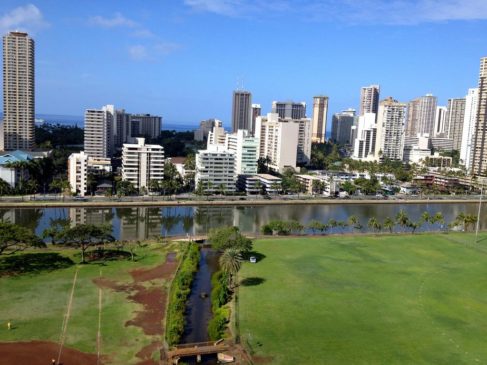
I was curious about Mufi’s thoughts on the contentious $345 million Ala Wai flood control project being planned by the US Army Corps of Engineers and my question was followed by a very interesting story about the difficult on-the-spot decision the then-Mayor Hannemann had to quickly make about “the worst sewage spill in state history.” In March of 2006 after 30 days of “rain of Biblical proportion,” the aging Waikiki sewer main ruptured, sending 48 million gallons of raw sewage into the Waikiki sewage system and into Waikiki’s streets. Mayor Hannemann only had two choices; 1) let the sewage flood many of Waikiki’s homes, hotels and other businesses or 2), divert the spill into the Ala Wai Canal. After a quick conference with the city engineers, Mufi made the hard decision to divert it into the canal. The net result was that the tourism economy did not suffer, and he fashioned the plan to rebuild the county’s aging sewage infrastructure system, honored his pledge to never raid the sewer fund, as had been done in the past, settled a decades long lawsuit against the city, and worked cooperatively with the EPA to resolve the problem. Mufi noted, “The Ala Wai watershed is a time bomb waiting to explode. Unfortunately, it make take another catastrophe” to bring the public around to understanding why some version of the proposed Army Corps of Engineers plan needs to begin ASAP. Understandably, the pushback is coming from the area residents whose property would be the most impacted by building a series of flood containment reservoirs along the Manoa and Palolo Valley streams. “It’s too bad that the City did not engage the community in a more meaningful way,” said Hannemann. “They need to do a better job of community engagement and public discussion.” While the debate about the complete plan goes on, the Corps of Engineers began in October of this year with the dredging of the Ala Wai Canal. The year-long $21 million project will remove an estimated 186,000 cubic yards of sediment and debris which has accumulated since the last dredging in 2002. Two sections of the canal wall including the one fronting Ala Wai Community Park will be repaired and the debate over the other proposed parts of the project will no-doubt continue.
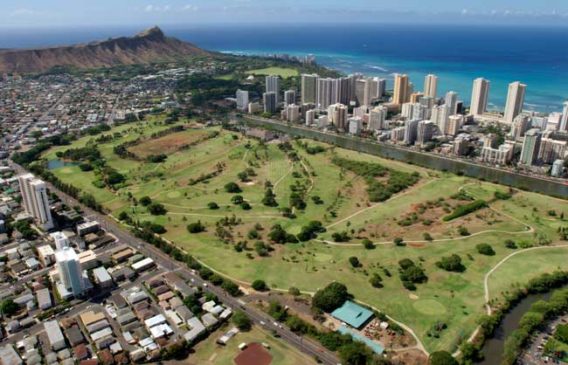
Mufi is supportive of building an earth berm around the entire Ala Wai golf course to create a huge emergency basin if and when the next major storm event occurs. Hannemann said, “There’s no reason to not do that part asap. The berm could be an attractive addition to the golf course and we would be that much further along in creating the needed flood control system. “I would support that now” he said.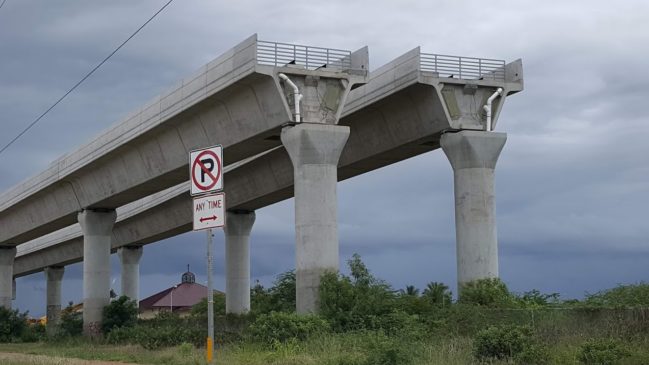 Honolulu Rail under construction
Honolulu Rail under construction
Hannemann brought up the Honolulu rail issue saying, “If you like rail you applaud me, if you hate it you have issues with me.” He is very disappointed in how the Honolulu Authority for Rapid Transportation (HART) has turned out. HART was created as a semi-autonomous organization by a vote of the people, ostensibly to take the politics out of the project. Hannemann said that a major mistake was the hiring of Daniel Grabauskas as the first executive director and CEO after he left office. To Hannemann’s point, I found cited on Wikipedia, “… Under his [Grabauskas] leadership, HART went over budget and fell behind schedule.” Grabauskas came to HART directly after heading Boston’s “Big Dig” which became “the most expensive highway project in the US, and was plagued by cost overruns, delays, leaks, design flaws, charges of poor execution and use of substandard materials…” When he left the Mayor’s office in the summer of 2010 to run for Governor, “the proof in the poi was that rail was on time, on budget, and on schedule, with a huge contingency fund, thanks to an excellent team that assisted me.” Hannemann stated, “however, today there are no genuine champions of rail as we have had in the past like Senator Inouye and Congressman Takai. Too many of the so-called proponents are playing it cute and safe. They will come out when there is good news to take photo ops and hold press conferences, but when it is negative news they run for cover and play hide-and-go-seek.” Mufi said he’s been urging HART to “… start interim service to the stadium sooner rather than later in 2020” and believes that “after people see, ride, and experience it, more people will like it, just like when H3 opened.” Hannemann believes “the current CEO of HART, Andy Robbins, who has construction rail experience, that Grabauskas lacked, is the right man at the right time for the project. The Federal Transit Administration, by and large, has been pleased by the work that he has done.” Hannemann related that he has read in engineering publications, that there is indeed serious interest from highly qualified bidders for a public–private partnership (P3) to complete the third and final segment to Ala Moana. Moreover, “if you like rail you are going to love transit oriented development (TOD) that is going to transform the communities that it services by creating affordable housing, commercial and retail development, and other improvements in the quality of life,” concluded Hannemann. Hannemann believes that the antiquated Oahu Community Correctional Center should be relocated because with rail coming, the existing OCCC property is way too valuable and should be utilized for new affordable housing and related commercial activities. The question was posed as to why the City & County permitting process takes so long. Hannemann said, “I was on the Council when former Mayor Harris initiated a series of sweeping proposals to consolidate city departments and not all of them were good ideas. For example, I was successful in helping to reject the idea of folding the Fire Department from a standalone entity into a merged Emergency Management Department. But there were other ideas that made it through the council vetting process, such as the Department of Planning and Permitting. Presently it is clear that a laser-like focus on the permitting process is what is needed because of the inordinate amount of delays that are taking place. Time is money and perhaps creating a separate standalone department of permitting should be looked into and see if that would be an improvement from what is currently happening.” If Mufi Hannemann is considering running for Mayor of Honolulu again and if the early September 2019, Star Advertiser poll is any indication, he would have a fair shot at it. After all he was elected twice as Mayor in 2004 and 2008, and twice as a councilmember from Aiea, Pearl City, and Waipahu in 1994 and 1998. Hannemann received the second-highest favorable recognition poll rating amongst 8 individuals who were evaluated. However, “Hannemann also had the highest percentage of poll respondents who said their opinion of him was unfavorable.” Time will tell of course what the very accomplished Mufi Hannemann does next. One thing that is very clear when you sit through a session like I did, you know where he stands and he is not afraid to make tough decisions.


